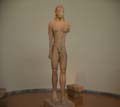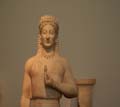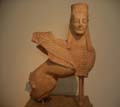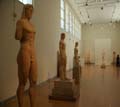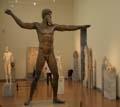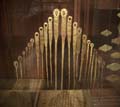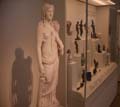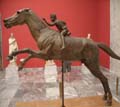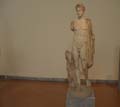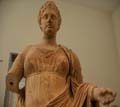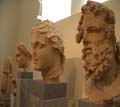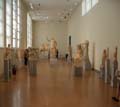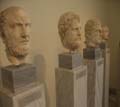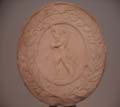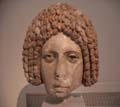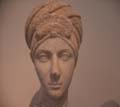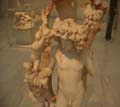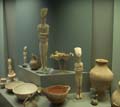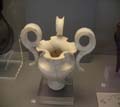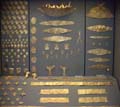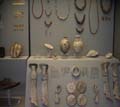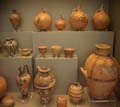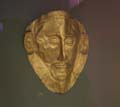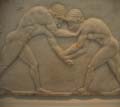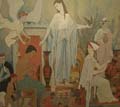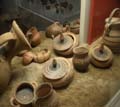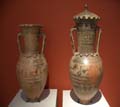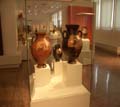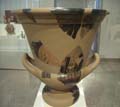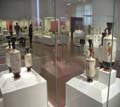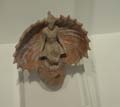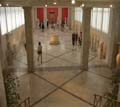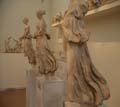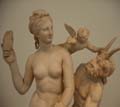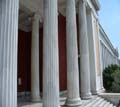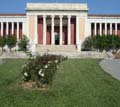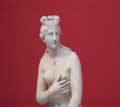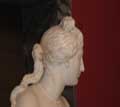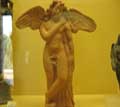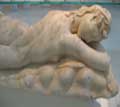
National Archaeological Museum
(Tositsa 1 National Archaeological Museum tel. 210 8217724)
It is located between Patision, Tositsa and Stournara streets and is the largest and richest of all Greek museums and one of the most important in the world, especially for the study of ancient Greek art. The need for the gathering of all Greek antiquities in a large museum seemed imperative already in the first years after the liberation. However, since this was not immediately possible, the first archaeologists and antiquarians began to collect the ancient finds in existing, but unsuitable by their nature, buildings.The first archaeological museum was founded in Aegina in March 1829 by Kapodistrias, with Andreas Mustoksydis from Corfu as curator. With the transfer of the capital to the National Archaeological Museum, the new capital became the main center for the collection of antiquities. Since 1834, it had been defined by a royal decree that Thisio would become the "Central Archaeological Museum", but because it was filled in a very short time, the ancient finds began to be housed in various other buildings. After various inconveniences and relocations of the antiquities, around 1866 the realization of the idea of the large museum began, when Eleni Tositsa donated the large plot of land on Patision Street to the state and the expatriate from St. Petersburg, Russia, Dimitrios Bernadakis, offered a considerable sum of money for the first tasks.
Until 1874, only the western side of the museum was finished, but until 1889, and with the continuous financial assistance of the state, the entire construction of the building was completed, which was named the "National Archaeological Museum" by decree of April 19, 1881. The exhibition of the ancients and especially the setting up of the sculptures had already begun with the care of the great archaeologists of the time, Panagiotis Kavvadias, Christos Tsoundas and Panagiotis Kastriotis.
But the enrichment of the museum took place with such speed during the following decades, due to the number of finds from excavations, purchases and donations, that from 1925, with the help of the state, its expansion began, which was ready in 1939. The war not only suspended every re-exhibition work, but also created the need to hide all the museum's antiquities, to protect them from bombings and other war dangers. After the end of the war and after many changes were made to the old wing, work began on the final exhibition of all the works in the now completed building. The then director of the National Museum, Christos Karouzos, was responsible for this re-exhibition.
Description: Immediately opposite the main entrance of the museum is the room of the Mycenaean exhibits that belong to the period from the 16th to the 11th BC. century. Most of these objects come from tombs and mainly from the two burial circles of Mycenae and less from palaces and houses. All the showcases are dominated by the works of metalwork (bronze weapons and utensils), goldsmithing, seal carving and small crafts in works of stone and ivory. The superiority of Mycenae is noticeable, since more than half of the finds come from their area. Most important are: the gold masks and the gold vessels and weapons from the two burial enclosures, the jewelry, and the seals from the vaulted and chambered tombs outside the Acropolis of Mycenae, the frescoes from the palace and the tombstones. From the other areas stand out the two golden cups of Vapheus, the Linear B tablets from Pylos, parts of frescoes from Tiryns and thousands of other objects from the centers of the Mycenaean culture. Two narrow halls are formed on the sides of the Mycenaean hall. On the left are exhibited objects from the Neolithic and Pre-Mycenaean period, and mainly vases, tools, figurines, and jewelry from the Thessalian citadels of Dimini and Sesklos, from the proto-Hellenic settlements of Attica (Askitario, Agios Kosmas, Nea Makri), as well as typical finds from two centers of NE culture. Aegean (Troy, Poliochni Limnos). fragments of frescoes from Tiryns and thousands of other objects from the centers of Mycenaean civilization. Two narrow halls are formed on the sides of the Mycenaean hall. On the left are exhibited objects from the Neolithic and Pre-Mycenaean period, and mainly vases, tools, figurines, and jewelry from the Thessalian citadels of Dimini and Sesklos, from the proto-Hellenic settlements of Attica (Askitario, Agios Kosmas, Nea Makri), as well as typical finds from two centers of NE culture. Aegean (Troy, Poliochni Limnos). fragments of frescoes from Tiryns and thousands of other objects from the centers of Mycenaean civilization. Two narrow halls are formed on the sides of the Mycenaean hall. On the left are exhibited objects from the Neolithic and Pre-Mycenaean period, and mainly vases, tools, figurines, and jewelry from the Thessalian citadels of Dimini and Sesklos, from the proto-Hellenic settlements of Attica (Askitario, Agios Kosmas, Nea Makri), as well as typical finds from two centers of NE culture. Aegean (Troy, Poliochni Limnos). and jewelry from the Thessalian citadels of Dimini and Sesklos, from the proto-Hellenic settlements of Attica (Askitario, Agios Kosmas, Nea Makri), as well as typical finds from two centers of the NE culture. Aegean (Troy, Poliochni Limnos). and jewelry from the Thessalian citadels of Dimini and Sesklos, from the proto-Hellenic settlements of Attica (Askitario, Agios Kosmas, Nea Makri), as well as typical finds from two centers of the NE culture. Aegean (Troy, Poliochni Limnos).
In the narrow hall on the right are the exhibits of the Cycladic civilization that flourished in the Cyclades during the early Bronze Age (3rd millennium BC). On display are the famous marble figurines (most notably the harpist and piper from Keros), vases and earthenware (mainly the curious pan-shaped ones), as well as many stone, bone and obsidian tools.
To the left of the vestibule of the museum and in seven contiguous rooms, the "light-enveloped" archaic sculptures, the famous kouros and daughters, as well as the funerary reliefs of the 6th century are exhibited. More important than these works are the gigantic kouroi of Souni, Tzia, Milos, Volomandra, Ptoos, which come from different artistic workshops and show the quest for the early monumental expression of Greek art. Also, the statues of the daughters, such as the early Nicandra, Agemo and Frasiklia, are important. We should also note the tomb monuments, but unusual reliefs, such as the column of Aristion from Velanideza and other paintings, such as the columns of Lyceum and Antiphanus. At the end of this period and together with other smaller, but most important, works of archaic art stand two bright Attic works from the end of the 6th century: Croesus from Anabyssos and Aristodikos from Mesogaia. Near them are the square bases of other kouras bearing reliefs, scenes of the sports and daily life of the ancient Athenians.
In the next rooms, the sculptures of 5 centuries, from 500 BC have been placed in chronological order. until 1 BC century, which show the brilliant course of Greek art and some of its most important stations. Among the most important, we should note the large Eleusinian relief with Demeter, the daughter and Triptolemus, the bronze statue of "Poseidon Artemisius" that was found at the bottom in 1926-28 and is a very important work of one of the leading coppersmiths of B. Peloponnese, perhaps of Kalamis (around 450 BC. Next is the hall of classical votive sculptures, i.e. small or larger reliefs and statues dedicated to ancient sanctuaries, temple propylae and sacred groves. The most important works are the reliefs of Echelos with Vasilis and Xenokrateia, which were found in N. Faliro and date back to around 410 BC.
After two small rooms of classical works - the most important of which are the "Athena of Lenormand" and the "Athena of Varvakei", which give an idea of the chryselephantine Athena Virgin of Pheidias - the rich collection of epitaph reliefs with works that combine the greatness of life and the sadness of death. Among the most important is the epitaph stele of Hegissa by Kerameikos. From the 4th century stand out the "column of Ilisos", around 340 BC, the epitaphic monument of the family of Procleides in the shape of a nave with a pediment (around 330 BC) and the epitaph naise of Aristonauts (310 BC), to reach 307 BC), when a prohibitory law stops the creation of "expensive" funerary works.
Among the most important rooms of the National Museum is the room of Epidaurus, which is dedicated to sculptures from the excavations made in the sanctuary of Asclepius (1882 - 1886). Most come from the pediments of the temple of Asclepius which represented, the eastern one, the fall of Troy and, the western one, the Battle of Amazonas, and from the capes of the same temple and the temple of Artemis. From the works of the 4th century of the later halls we should note: a) the bronze statue of the young man from Antikythera, found at the bottom of the sea in 1900; A great work of a sculptor of the Northern Peloponnese, around 340 BC, which perhaps pictures, according to the most convincing interpretation, Paris b) three heads from the pediments of the temple of Alea Athena in Tegea, probably works of the great Skopas, as well as the head of Hygeia, perhaps the cult statue of the temple, which is the culmination of classical Greekness in the formation of the ideal of the goddess (around 360 BC) c) the three plates with a relief representation of the musical struggle of Apollo and Marsyas from the basis of a praxiteletic work in Mantineia (around 320 BC) and d) the bronze head of a boxer from Olympia, perhaps the work of the sculptor Silanion (mid-4th century).
The works of the Hellenistic and Roman periods follow, but are less representative, because from the time of M. Alexander the centers of culture were moved to Asia Minor and the cities of the eastern Mediterranean. The most important are: a) from the 3rd century BC, the large statue of the goddess Themis that was found in 1890 in Ramnountas of Attica, inside the temple of the goddess, a work of the sculptor Chaerestratos, and the bronze head, of the so-called "philosopher of Antikythera", which perhaps represents the Cynic Vion of Borysthenitis b) from the late Hellenistic and Roman times we should distinguish the colossal statue of Poseidon from Milos found in 1877, the large heads and part of the "sacred cloth" of the gods of Lykosoura, works of the Messinian sculptor Damophon, Zeus of Aigeira by the Athenian sculptor Euclid, as well as the complex of Aphrodite and Pan found in 1904 in Dios and dated around 100 BC.
At the National Archaeological Museum, the bronze figurines, vases and small objects of the Karapanos collection, most of which come from Dodoni and give a complete picture of Greek metalwork from the 6th BC, are of interest. century until the Roman years. But in the last of the bronze halls one can admire original works of Greek bronze sculpture and take only a small sample of the large production of bronze statues, of which unfortunately only a few of her works have survived to the present day. The most important is the Apollo of Piraeus, the oldest large bronze statue, which can be dated around 520 BC. Along with this Apollo were found in 1959 in Piraeus and other original works dating mainly to the middle of the 4th century, the most important of which is Athena of Piraeus, attributed to Praxiteles. In the school of the same artist who was found at the bottom of the Marathon sea.
The second floor of the north and west wing houses the collection of vases of the National Museum in 10 rooms. At the beginning, the vessels of the bronze period (3rd - 2nd millennium BC) are exhibited. The collection of protogeometric and geometric vases is very rich, especially the large amphorae and kraters of the so-called "Dipylos style". In an addition, the small clay wine jar that preserves the oldest Greek inscription is exhibited. In the rest of the rooms are exhibited vases of the oriental style, proto-Attic, black-figure and red-figure from various places and mainly from Attica, which was one of the most important workshops of ancient Greek pottery. Unique in the world is the collection of white lykyths with their debased ethereal forms, produced for about half a century (460 - 400 BC).
On the upper floor of the Museum, the wall paintings recently discovered in the Akrotiri settlement of Thira are also temporarily exhibited. Stand out are the life-sized figures of women or boxers and the fisherman, which decorated the houses of the wealthy sailors of Akrotiri, the two antelopes, the "spring mural" with swallows and the unique miniature of the departure of the ships.
Moreover, the Museum's collection of jewels from all periods of antiquity and mainly from the Hellenistic and Roman periods (Collection of Eleni Stathatou) is also rich.
In addition to the objects of the exhibitions, the Museum also has huge warehouses, where there is a multitude of more or less important works of ancient art. In addition, the National Archaeological Museum operates casting workshops, where plaster copies of original works are made, for anyone who wants to acquire one of the works that marked the history of world art.
Editor: Fotini Anastasopoulou










